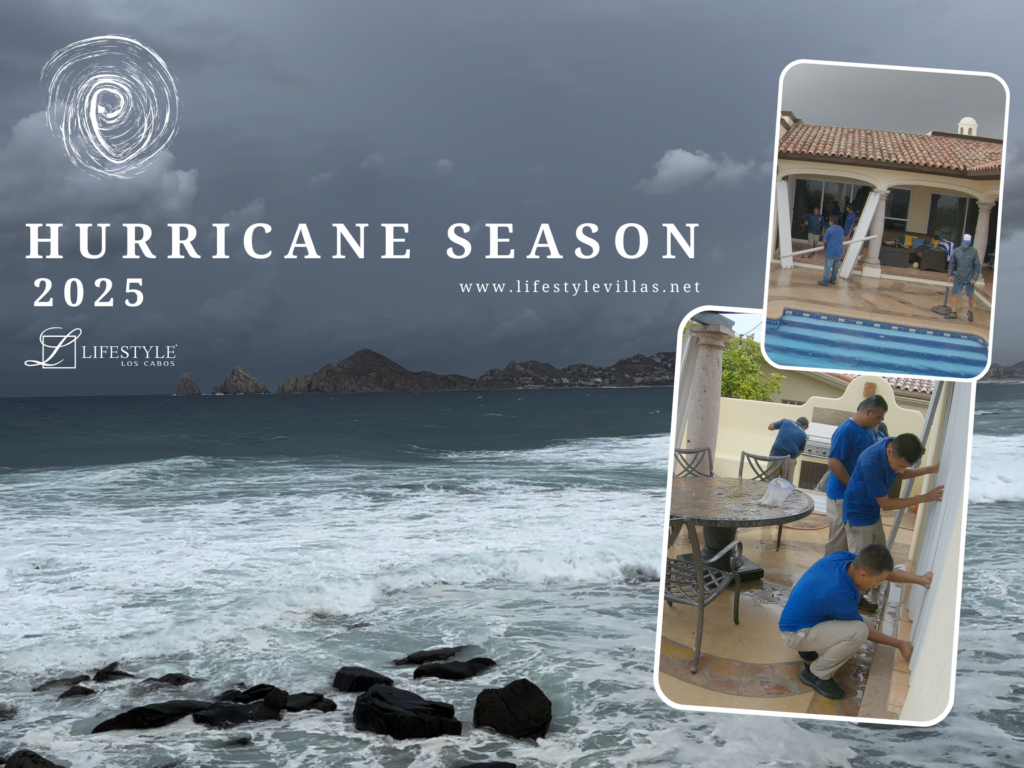The Pacific Ocean hurricane season officially began on May 15th, according to the National Meteorological Service (SMN), an agency of the National Water Commission (Conagua), and will conclude on November 30th.
Between 16 and 20 hydrometeorological phenomena are expected for this season. According to experts, the formation of 8 to 9 tropical storms, 4 to 5 Category 1 and 2 hurricanes, and 4 to 6 Category 3, 4, and 5 hurricanes is expected this year.
A culture of prevention for these meteorological phenomena is essential to stay as calm and safe as possible. Staying informed is the primary tool we have to implement the necessary protocols and thus properly reduce risk situations. Experience the perfect blend of luxury and safety with our Cabo San Lucas vacation rentals. At Lifestyle Villas, LIFESTYLE is at the forefront of all procedures to ensure our guests feel secure and cared for during any weather conditions. Enjoy the beauty of Cabo with peace of mind.
Key Villa Preparation Recommendations for Los Cabos
Most homes in Los Cabos are constructed with cinder block and concrete, offering substantial protection against hurricane-force winds and flying debris. However, it’s crucial not to overlook the hazards posed by exterior objects. Evaluate your home’s surroundings, identify anything that could become airborne during a storm and secure or remove it to prevent damage to your villa or neighboring properties. Even with robust construction, proactive attention to these details is essential for comprehensive hurricane safety.
Los Cabos’ rapid development has made water flow during heavy rains less predictable, so extra vigilance is needed.
1. Proactive Property Maintenance
• Begin early: In June, trim trees and plants near structures and thoroughly clean all gutters, drains, and grates—including terraces, roofs, gardens, and pump rooms.
• Test and maintain security systems and emergency generators, ensuring LPG gas supply and proper function.
• Inspect and repair roof waterproofing; check all seals on windows, doors, and skylights.
• Turn off gas valves before the storm hits.
2. Structural Protection
• Install hurricane shutters or panels on windows and glass doors.
• Reinforce garage doors and secure gates.
• Use sandbags in exposed areas, as shutters are not watertight.
• Remove or secure all outdoor furniture, electronics, grills, and decorations to prevent wind damage.
3. Interior Preparations
• In July and August, remove carpets; for unoccupied homes, fully break down and secure the property as if a major storm is imminent.
• Store valuables and electronics in safe, elevated locations.
• Keep emergency lighting—flashlights or battery-powered lanterns—on hand; avoid candles due to fire risk.
4. Emergency Supplies & Communication
• Maintain an emergency kit with non-perishable food, water, medications, first aid, batteries, and a battery-powered radio.
• Keep extra gasoline, backup power sources, and, if possible, satellite internet and an off-road vehicle for emergencies.
• Store important documents (insurance, IDs, medical records) in waterproof containers or digitally.
• Battery powered radios.
• If you have guests in residence, ensure every bedroom has cleaning supplies: towels, mops, buckets, brooms, and dry clothes.
• Fill buckets and tubs before the storm for flushing toilets and washing, as power outages mean no water pump.
• Local Bilingual Radio Stations:
o Cabo Mil (96.3 FM) – Cabo San Lucas
o Radiante FM (89.1 FM) – San José del Cabo
o La Radio de Sudcalifornia (99.1 FM) – Cabo San Lucas
Stay updated by listening to these stations for emergency information in both Spanish and English.
• Important websites to track storms:
Here is a list of official weather websites for the USA and Mexico, including those specifically focused on hurricanes and severe weather:
United States
• Agency/Center
• Focus
• Website
• National Hurricane Center (NHC)
• Hurricanes & tropical storms
• nhc.noaa.gov
México
• Servicio Meteorológico Nacional (SMN, part of CONAGUA)
• National weather & hurricanes
• smn.conagua.gob.mx
5. Evacuation & Safety Planning
• Know local evacuation routes and shelter locations; share your plan with all family members.
• Follow all civil protection and HOA guidelines, which now require stricter compliance to minimize risk for both residents and staff.
• During a storm, stay indoors, away from windows and exterior walls, and monitor official updates from authorities and the National Hurricane Center. Windows may bow and expand; to relieve pressure, consider opening a window on the side opposite the wind, but only if safe to do so.
• Know the high points on your property and surrounding area in case of flash flooding.
6. After the Storm
• Return home only when authorities declare it safe.
• Watch for hazards such as downed power lines and flooding.
• Wear shoes and inspect your property for damage before restarting generators or electrical systems.
• Avoid driving around town to survey damage; instead, help clean around your home and neighborhood first.
Additional Notes:
• Los Cabos authorities and HOAs have robust emergency protocols; compliance is mandatory for safety and insurance.
• With the changing landscape, drainage and flooding risks may be higher in newly developed areas.
• Stay informed with your neighbors, and remember your Cabo LIFESTYLE Team is always on call for any assistance.
Summary:
Preparation, vigilance, and community cooperation are the best ways to ensure safety and minimize damage. When LIFESTYLE Los Cabos manages your asset, we handle all the little details so you can focus on living the life you deserve.
If you have questions or need support, don’t hesitate to contact our team.

